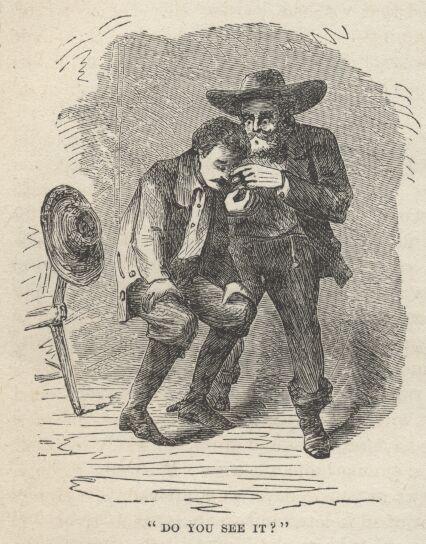 "I met men at every turn who owned from one thousand to thirty thousand “feet” in undeveloped silver mines, every single foot of which they believed would shortly be worth from fifty to a thousand dollars—and as often as any other way they were men who had not twenty-five dollars in the world. Every man you met had his new mine to boast of, and his “specimens” ready; and if the opportunity offered, he would infallibly back you into a corner and offer as a favor to you, not to him, to part with just a few feet in the “Golden Age,” or the “Sarah Jane,” or some other unknown stack of croppings, for money enough to get a “square meal” with, as the phrase went. And you were never to reveal that he had made you the offer at such a ruinous price, for it was only out of friendship for you that he was willing to make the sacrifice. Then he would fish a piece of rock out of his pocket, and after looking mysteriously around as if he feared he might be waylaid and robbed if caught with such wealth in his possession, he would dab the rock against his tongue, clap an eyeglass to it, and exclaim:
"I met men at every turn who owned from one thousand to thirty thousand “feet” in undeveloped silver mines, every single foot of which they believed would shortly be worth from fifty to a thousand dollars—and as often as any other way they were men who had not twenty-five dollars in the world. Every man you met had his new mine to boast of, and his “specimens” ready; and if the opportunity offered, he would infallibly back you into a corner and offer as a favor to you, not to him, to part with just a few feet in the “Golden Age,” or the “Sarah Jane,” or some other unknown stack of croppings, for money enough to get a “square meal” with, as the phrase went. And you were never to reveal that he had made you the offer at such a ruinous price, for it was only out of friendship for you that he was willing to make the sacrifice. Then he would fish a piece of rock out of his pocket, and after looking mysteriously around as if he feared he might be waylaid and robbed if caught with such wealth in his possession, he would dab the rock against his tongue, clap an eyeglass to it, and exclaim:
“Look at that! Right there in that red dirt! See it? See the specks of gold? And the streak of silver? That’s from the Uncle Abe. There’s a hundred thousand tons like that in sight! Right in sight, mind you! And when we get down on it and the ledge comes in solid, it will be the richest thing in the world! Look at the assay! I don’t want you to believe me—look at the assay!”"
"Then he would get out a greasy sheet of paper which showed that the portion of rock assayed had given evidence of containing silver and gold in the proportion of so many hundreds or thousands of dollars to the ton.
I little knew, then, that the custom was to hunt out the richest piece of rock and get it assayed! Very often, that piece, the size of a filbert, was the only fragment in a ton that had a particle of metal in it—and yet the assay made it pretend to represent the average value of the ton of rubbish it came from!
On such a system of assaying as that, the Humboldt world had gone crazy. On the authority of such assays its newspaper correspondents were frothing about rock worth four and seven thousand dollars a ton!
And does the reader remember, a few pages back, the calculations, of a quoted correspondent, whereby the ore is to be mined and shipped all the way to England, the metals extracted, and the gold and silver contents received back by the miners as clear profit, the copper, antimony and other things in the ore being sufficient to pay all the expenses incurred? Everybody’s head was full of such “calculations” as those—such raving insanity, rather. Few people took work into their calculations—or outlay of money either; except the work and expenditures of other people.
We never touched our tunnel or our shaft again. Why? Because we judged that we had learned the real secret of success in silver mining—which was, not to mine the silver ourselves by the sweat of our brows and the labor of our hands, but to sell the ledges to the dull slaves of toil and let them do the mining!" (Roughing It)